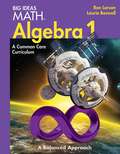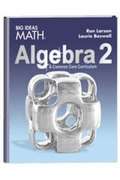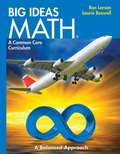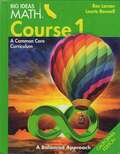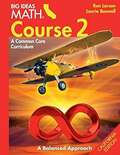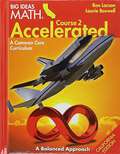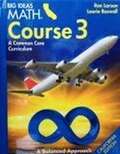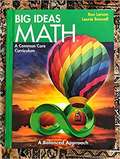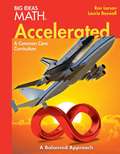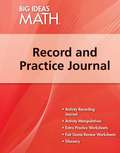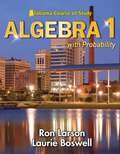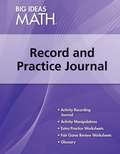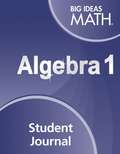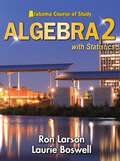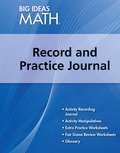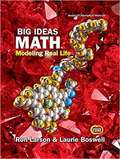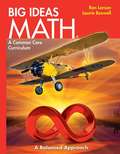- Table View
- List View
Big Ideas Math: A Common Core Curriculum, Algebra 1
by Ron Larson Laurie BoswellNIMAC-sourced textbook
Big Ideas Math: A Common Core Curriculum, Algebra 1
by Ron Larson Laurie BoswellNIMAC-sourced textbook
Big Ideas Math: A Common Core Curriculum, Algebra 1
by Ron Larson Laurie BoswellNIMAC-sourced textbook
Big Ideas Math: A Common Core Curriculum, Algebra 1 (Big Ideas Math Algebra 1 Ser.)
by Ron Larson Laurie BoswellNIMAC-sourced textbook
Big Ideas Math: A Common Core Curriculum, Algebra 2
by Ron Larson Laurie BoswellNIMAC-sourced textbook. <P> <i>Advisory: Bookshare has learned that this book offers only partial accessibility. We have kept it in the collection because it is useful for some of our members. To explore further access options with us, please contact us through the Book Quality link on the right sidebar. Benetech is actively working on projects to improve accessibility issues such as these. </i>
Big Ideas Math: A Common Core Curriculum, Course 1
by Ron Larson Laurie BoswellNIMAC-sourced textbook
Big Ideas Math: A Common Core Curriculum, Course 2
by Ron Larson Laurie BoswellNIMAC-sourced textbook
Big Ideas Math: A Common Core Curriculum, Course 2 Accelerated
by Ron Larson Laurie BoswellNIMAC-sourced textbook
Big Ideas Math: A Common Core Curriculum, Course 3
by Ron Larson Laurie BoswellNIMAC-sourced textbook
Big Ideas Math: A Common Core Curriculum, Geometry
by Ron Larson Laurie BoswellNIMAC-sourced textbook
Big Ideas Math: A Common Core Curriculum, Red Accelerated
by Ron Larson Laurie BoswellNIMAC-sourced textbook
Big Ideas Math: A Common Core Curriculum, Red Accelerated
by Ron Larson Laurie BoswellNIMAC-sourced textbook
Big Ideas Math: A Common Core Curriculum, Red, Record and Practice Journal
by Ron Larson Laurie BoswellNIMAC-sourced textbook
Big Ideas Math: Algebra 1, A Common Core Curriculum, Record And Practice Journal
by Ron Larson Laurie BoswellNIMAC-sourced textbook
Big Ideas Math: Blue, A Common Core Curriculum, Record And Practice Journal
by Ron Larson Laurie BoswellNIMAC-sourced textbook
Big Ideas Math: Common Core Curriculum Green
by Houghton Mifflin Harcourt Publishing Company StaffConsistent with the philosophy of the Common Core State Standards and Standards for Mathematical Practice, the Big Ideas Math Student Edition provides students with diverse opportunities to develop problem-solving and communication skills through deductive reasoning and exploration. Students gain a deeper understanding of math concepts by narrowing their focus to fewer topics at each grade level. Students master content through inductive reasoning opportunities, engaging activities that provide deeper understanding, concise, stepped-out examples, rich, thought-provoking exercises, and a continual building on what has previously been taught.
Big Ideas Math: Common Core Grade 7
by Ron LarsonConsistent with the philosophy of the Common Core State Standards and Standards for Mathematical Practice the Big Ideas Math: Modeling Real Life Student Edition features several components to help position students for success and keep them on the right track for mathematical proficiency. The Big Ideas Math Student Edition provides students with learning targets and success criteria at the chapter and lesson level to make learning visible. Diverse opportunities to develop problem-solving and communication skills through deductive reasoning and exploration are also prominent throughout the text. Students gain a deeper understanding of math concepts by narrowing their focus to fewer topics at each grade level. Students master content through inductive reasoning opportunities, engaging activities that provide deeper understanding, concise, stepped-out examples, rich, thought-provoking exercises, and building connections to previous skills for coherence.
Big Ideas Math: Common Core Student Edition Red 2014
by Houghton Mifflin Harcourt Publishing Company StaffBig Ideas Math: Common Core Student Edition Red 2014 - Math Textbook
